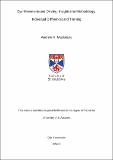Files in this item
Eye movements and driving : insights into methodology, individual differences and training
Item metadata
| dc.contributor.advisor | Harris, Julie | |
| dc.contributor.author | Mackenzie, Andrew K. | |
| dc.coverage.spatial | 207 p. | en_US |
| dc.date.accessioned | 2018-07-24T13:58:02Z | |
| dc.date.available | 2018-07-24T13:58:02Z | |
| dc.date.issued | 2016 | |
| dc.identifier.uri | https://hdl.handle.net/10023/15690 | |
| dc.description.abstract | Driving is a complex visuomotor task, and the study of eye movements can provide interesting and detailed insights into driving behaviour. The aim of this thesis was to understand (a) what methods are useful to assess driving behaviour, (b) the reasons we observe differences in eye movements when driving, and (c) offer a possible visual training method. The first experiment compared drivers’ eye movements and hazard perception performance in an active simulated driving task and a passive video driving task. A number of differences were found, including an extended horizontal and vertical visual search and faster response to the hazards in the video task. It was concluded that when measuring driving behaviour in an active task, vision, attention and action interact in a complex manner that is reflected in a specific pattern of eye movements that is different to when driving behaviour is measured using typical video paradigms. The second experiment investigated how cognitive functioning may influence eye movement behaviour when driving. It was found that those with better cognitive functioning exhibited more efficient eye movement behaviour than those with poorer cognitive functioning. The third experiment compared the eye movement and driving behaviour of an older adult population and a younger adult population. There were no differences in the eye movement behaviour. However, the older adults drove significantly slower, suggesting attentional compensation. The final experiment investigated the efficacy of using eye movement videos as a visual training tool for novice drivers. It was found that novice drivers improved their visual search strategy when driving after viewing videos of an expert driver’s eye movements. The results of this thesis helps to provide insights into how the visual system is used for a complex behaviour such as driving. It also furthers the understanding of what may contribute to, and what may prevent, road accidents. | en |
| dc.description.abstract | ||
| dc.language.iso | en | en_US |
| dc.publisher | University of St Andrews | |
| dc.subject.lcc | QP477.5M2 | |
| dc.subject.lcsh | Eye--Movements | en |
| dc.subject.lcsh | Motor vehicle driving--Psychological aspects | en |
| dc.title | Eye movements and driving : insights into methodology, individual differences and training | en_US |
| dc.type | Thesis | en_US |
| dc.contributor.sponsor | Engineering and Physical Sciences Research Council (EPSRC) | en_US |
| dc.type.qualificationlevel | Doctoral | en_US |
| dc.type.qualificationname | PhD Doctor of Philosophy | en_US |
| dc.publisher.institution | The University of St Andrews | en_US |
This item appears in the following Collection(s)
Items in the St Andrews Research Repository are protected by copyright, with all rights reserved, unless otherwise indicated.

